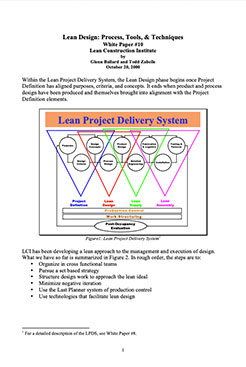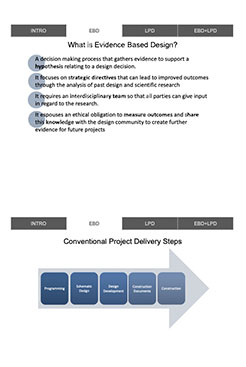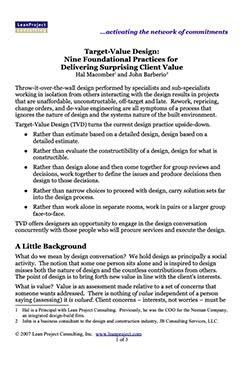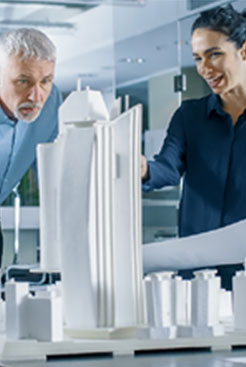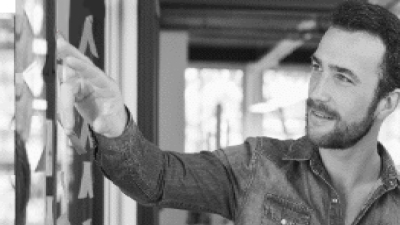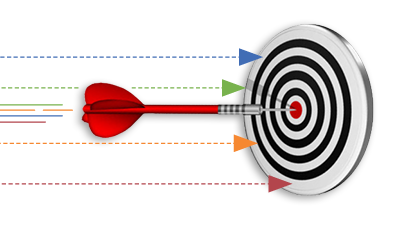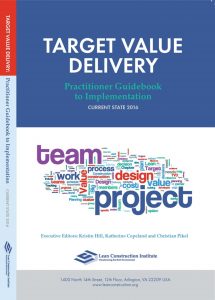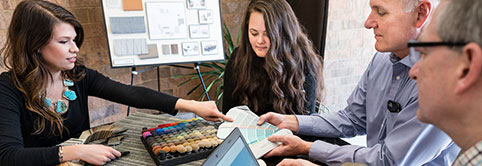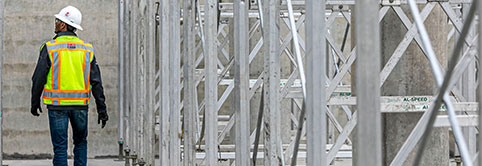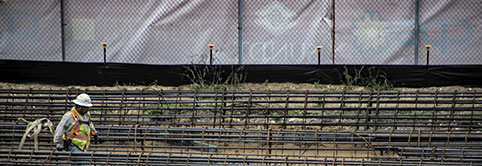Lean in Design
(Lean A&E)
An Introduction to Lean Architecture & Engineering
Bringing Lean approaches in the design phase (architecture and engineering) more frequently leads to a successful project outcome. Lean in design eliminates waste occurring from a lack of collaborative planning, inevitably affecting value for the customer. It works to mitigate the siloed thinking and re-work that results from conventional project delivery.
What is Lean in Design?
Lean in design, also known as Lean Architecture and Engineering or Lean A&E, focuses on four key concepts: team collaboration, problem solving, decision making skills and sharing information. With a Lean mindset, design engineers and architecture teams can share information freely and collaboratively to solve difficult problems and make decisions quickly and efficiently. Thus, design professionals increase value for the customers and for the stakeholders.
Lean Integrated Design
Lean integrated design fosters a different approach to design. Lean focuses heavily on driving innovation and design excellence by removing the eight types of waste found in any production process. Through eliminating these wastes, productivity is increased and value for customers and stakeholders is enhanced. From an overabundance of materials to underutilized talent, the 8 wastes are as follows.
- Defects
- Waiting
- Transportation of Goods
- Motion
- Inventory
- Overproduction
- Unnecessary Process Steps
- Non-utilized Talent
Facets of Lean in Design
By understanding waste and eliminating it wherever possible, LCI and the design community can improve both the process of design and product of design.
Improvement to the Process of Design
Lean thinking focuses on ways to eliminate waste in processes by introducing more cross-functional collaboration, team-wide planning and with focus on making holistic decisions. At its core, Lean principles promote effective teamwork, no matter the size of the team. Integrating teams, both large and small, using Lean project delivery methods improves the design process and generates value.
Improvement to the Product of Design
Collaboration breeds innovation. Design excellence can be greatly enhanced through input from all stakeholders involved with a project – from owners, general contractors and subcontractors to all involved in the engineering design process. Ultimately, looking at the project design through a different lens allows teams who use Lean mindsets to see tremendous improvements in the ability to creatively and effectively solve problems, thus improving the product of design.
When product designers collaboratively plan and problem solve, they solve some of the most daunting aspects of engineering and architecture, together. Through everything from work clustering and pull planning to effective Big Rooms, Lean design organizes work to advance together – not off in silos.
Why Apply Lean in the Design Phase?
In today’s world, design suffers from a lack of collaboration. The design-build and design-bid-build contract structures inherently prevent collaboration between design and construction phases, leading to a number of rework requests that can back up project completion timelines.
As a result of this, 70% of construction projects are delivered late and 73% are delivered over-budget. This is due to an excess of rework requests and high amounts of waste, leading to dissatisfied customers and shrinking profit margins. In fact, just 9% of owners believe they are achieving a high level of excellence in total project performance.
Meanwhile, designers under the current model have very little incentive to innovate or to find the best possible product design for the stakeholders involved. By applying Lean principles, the design and construction teams can not only collaborate but are financially encouraged to do so in order to find the best possible outcomes for stakeholders.
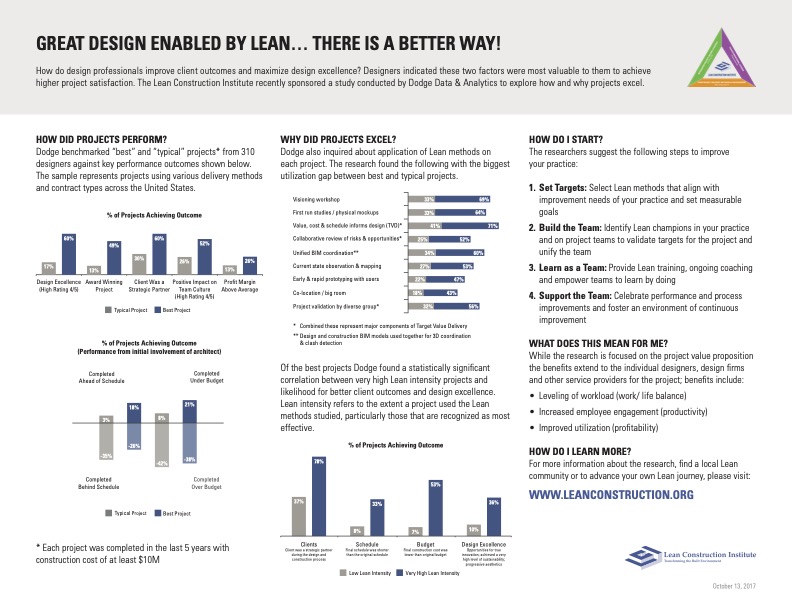
LCI Research
LCI and Dodge Data and Analytics benchmarked “best” and “typical” projects from 310 designers against key performance outcomes shown below. Of the best projects Dodge found a statistically significant correlation between very high Lean intensity projects and likelihood for better client outcomes and design excellence.
Download LCI Research: Great Design Enabled by Lean
Benefits of Lean Architecture & Lean Engineering
Designers who have implemented Lean methods see a sharp increase in productivity and project outcomes. These designers also see an increase in profit and a higher percentage of projects completed on-time. Most importantly, Lean thinking more often results in greater levels of design excellence and innovation.
What is Target Value Delivery (TVD) in Lean Design?
Target Value Delivery (TVD) is a disciplined management practice used throughout the lifetime of the design phase assuring that facilitators meet the operational needs and values of their users and deliver projects within the allowable budget. By establishing the target value at the onset, contractors, owners, and designers promote innovation throughout the design process to increase value by saving time, money and human effort.
Target Value Design encompasses the Target Value Delivery approaches implemented during the design delivery phases of the project. The goal of Target Value Design is to minimize the waste produced by the design-estimate-redesign cycle(s) of the traditional value engineering approach.
How to Implement a Lean Operating System in the Design Process
If you believe that utilizing a Lean system of project delivery is the right step for your next project, consider familiarizing yourself with Lean principles, practices, and design tools.
Understand the Lean Principles of Design
The first step towards implementing Lean in the design development process is to adhere to the Six Tenets of the Lean Construction Institute:
Utilizing Lean Design Practices & Tools
Lean designers can take advantage of several practices and tools to streamline their implementation of Lean methods.
Work Cluster Organization
A selection of leaders from coordinating teams that remain in constant coordination and communication with one another to enhance flow and decrease waste.
Big Room Mindset
A project approach aimed at bringing key individuals together to speed up communication, improve decision-making, and reduce siloed thinking or approaches.
Last Planner System® in Design
A system for project production planning and control, aimed at creating a workflow that achieves reliable execution.
A3 Thinking
A collaborative Lean methodology that supports sound decision making by including all key stakeholder perspectives.
Set-Based Design
A method that keeps requirements and options flexible for as long as possible in design.
Conditions of Satisfaction
A way to clearly establish the project as a promise thus creating a culture of accountability. When used as check-points, conditions of satisfaction drive creative tension leading to innovation.
Learning Lean in Design
The Lean Construction Institute is committed to transforming the design and construction industry by providing educational resources, conducting research, and facilitating local and national Lean events. It is only through the power of the LCI Corporate Members that LCI is able to offer the supplementary resources below to further your Lean journey.
Lean Assessments
How strong is your Lean knowledge? Take a Lean assessment to determine your current state so you have a baseline for improvement. Lean assessments are available for individuals, teams, and organizations alike. Whether you’re new to Lean or are an experienced Lean practitioner, Lean assessments are a great way to get started at LCI!
TAKE ASSESSMENTMore Lean Topics
From 5s to IPD, explore popular Lean design and construction topics below.

